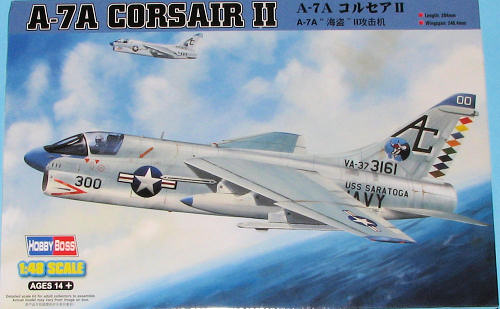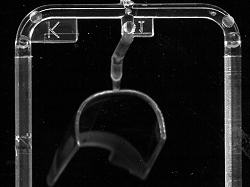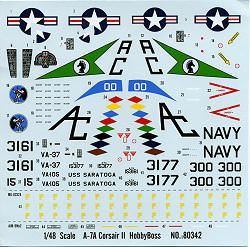
HobbyBoss 1/48 A-7A Corsair II
| KIT #: | 80342 |
| PRICE: | $68.99 SRP |
| DECALS: | Two options |
| REVIEWER: | Scott Van Aken |
| NOTES: | New mold kit |

| HISTORY |
The Ling-Temco-Vought A-7 Corsair II is a carrier-based subsonic light attack aircraft introduced to replace the United States Navy's A-4 Skyhawk, initially entering service during the Vietnam War. The Corsair was later adopted by the United States Air Force, to include the Air National Guard, to replace the A-1 Skyraider, F-100 Super Sabre and F-105 Thunderchief. The aircraft was also exported to Greece in the 1970s, and Portugal and Thailand in the late 1980s. The A-7 airframe design was based on the successful supersonic F-8 Crusader produced by Chance Vought. It was one of the first combat aircraft to feature a head-up display (HUD), an inertial navigation system (INS), and a turbofan engine.
The A-7 enjoyed the fastest and most trouble free development period of any American combat aircraft since World War II. The YA-7A made its first flight on 27 September 1965, and began to enter Navy squadron service late in 1966. The first Navy A-7 squadrons reached operational status on 1 February 1967, and began combat operations over Vietnam in December of that year.
The A-7A and subject of this kit was the first production version. Early USN Corsair IIs had two 20 mm Colt Mk 12 cannons with 250 rounds per gun. Maximum ordnance, carried primarily on the wing pylons, was theoretically 15,000 lb (6,804 kg), but was limited by maximum takeoff weight, so the full weapon load could only be carried with greatly reduced internal fuel; 199 built. Many were later refurbished for Portugal and sold as A-7Ps. New build A-7H airframes were supplied to Greece while Thailand got refurbished A-7Es as the types only export customers.
| THE KIT |
 Many are going to think that this is just a downsized Trumpeter 1/32 kit, but one has to remember that the Trumpeter kit was an A-7E while this is an earlier A version. There are bits and pieces on the sprue that are only applicable to the A-7E so perhaps one is coming. Not having built the big Corsair II, I'm not sure what the issues were concerning it and will leave that up to those who know more than I to decide.
Many are going to think that this is just a downsized Trumpeter 1/32 kit, but one has to remember that the Trumpeter kit was an A-7E while this is an earlier A version. There are bits and pieces on the sprue that are only applicable to the A-7E so perhaps one is coming. Not having built the big Corsair II, I'm not sure what the issues were concerning it and will leave that up to those who know more than I to decide.
The kit is nicely molded in the current style of lots of indented rivets. I found just a few sink areas on the outside of gear doors where there is a lot of internal detail. The kit has a well done cockpit with raised instrument details on the main panel and side consoles. Decals are also provided in case you wish to go that route. The seat is a bit plain looking and like most kits, could do with a more detailed replacement, or at least a harness.
The wheel wells are fully detailed and the intake goes back to the end of the cockpit area. Also detailed are the external avionics bays with covers that can be posed open. Now in the USAF, it was common to see some of these open, but not in the Navy where the salt air environment made this a foolish thing to do. Still, that option is there if you want to make yours land based. Full weapons pylons and a broad array of things to carry under the wings are provided. In fact, two sprues are nothing more than weapons. You get Sidewinders, Mk 80 series slick bombs with MERS, a pair of fuel tanks (which were frequently carried despite the Corsair II's excellent range without them), some more modern LGBs which are probably not appropriate for the A model and a FLIR pod (which was also not appropriate for the A model. The kit includes a load-out sheet which shows the fuel tanks being carried on the outer pylons. This is wrong. From what I understand, only the inner pylons were plumbed for the drop tanks. At least, that is where I've a
them), some more modern LGBs which are probably not appropriate for the A model and a FLIR pod (which was also not appropriate for the A model. The kit includes a load-out sheet which shows the fuel tanks being carried on the outer pylons. This is wrong. From what I understand, only the inner pylons were plumbed for the drop tanks. At least, that is where I've a lways seen them carried.
lways seen them carried.
Two things about the kit struck me. One is that the intake doesn't seem round enough. looking at photos, it seems the kit intake is too flat on the bottom. Same with the canopy. It seems a bit too flat-topped. Much like the Monogram A-7A and if that was used for a basis for this kit, that explains much. They should have chosen the Fujimi 1/72 kit as they seem to have gotten it right. Here is an image of the intake and and another of the canopy so you can judge for yourself. The canopy has a prominent mold seam running down the middle of it so it is something you'll have to sand away.
 Instructions are quite well done. There is an nice parts diagram with a listing of unused pieces. Paints shown are the usual Gunze references with generic names included. The insides of the equipment bays are listed as Interior Green. most photos I've seen are Chromate Yellow, but I have seen one or two USAF planes with these areas in Interior Green. Markings are for two colorful planes. One is the CAG bird from VA-37 in 1971 when aboard the USS Saratoga. This plane was eventually modded to A-7P standards and sent to Portugal. The nose and lower forward canopy need to be painted to match the blue of the fin tip marking. The other is a line bird from VA-105 in the early markings and not the full green tail as used with the A-7E. Oddly, the VA-105 plane has no nose number. It should be 415. Both are in the Light Gull Grey over White scheme. The decals are superbly printed. I know some have had issues with them, but I am not one of them. However, I have a ton of old Microscale sheets and will probably use one of them instead.
Instructions are quite well done. There is an nice parts diagram with a listing of unused pieces. Paints shown are the usual Gunze references with generic names included. The insides of the equipment bays are listed as Interior Green. most photos I've seen are Chromate Yellow, but I have seen one or two USAF planes with these areas in Interior Green. Markings are for two colorful planes. One is the CAG bird from VA-37 in 1971 when aboard the USS Saratoga. This plane was eventually modded to A-7P standards and sent to Portugal. The nose and lower forward canopy need to be painted to match the blue of the fin tip marking. The other is a line bird from VA-105 in the early markings and not the full green tail as used with the A-7E. Oddly, the VA-105 plane has no nose number. It should be 415. Both are in the Light Gull Grey over White scheme. The decals are superbly printed. I know some have had issues with them, but I am not one of them. However, I have a ton of old Microscale sheets and will probably use one of them instead.
| CONCLUSIONS |
The intake thing could be a deal breaker for some and frankly, I wish it hadn't been done like that as there are lots of photos and museum aircraft from which Hobby Boss could have used when designing the kit. The rest of it looks to be very well done and despite the fact that one rarely saw an A-7 on the ground with the flaps down, it is nice to have that as an option. I would have liked to have seen foldable wing tips on this one, but those handy with a razor saw can do the modifications needed.
| REFERENCES |
August 2009
Thanks to Squadron Products for the review kit. Get yours at your favorite shop or on-line retailer. If you would like your product reviewed fairly and fairly quickly, please contact the editor or see other details in the